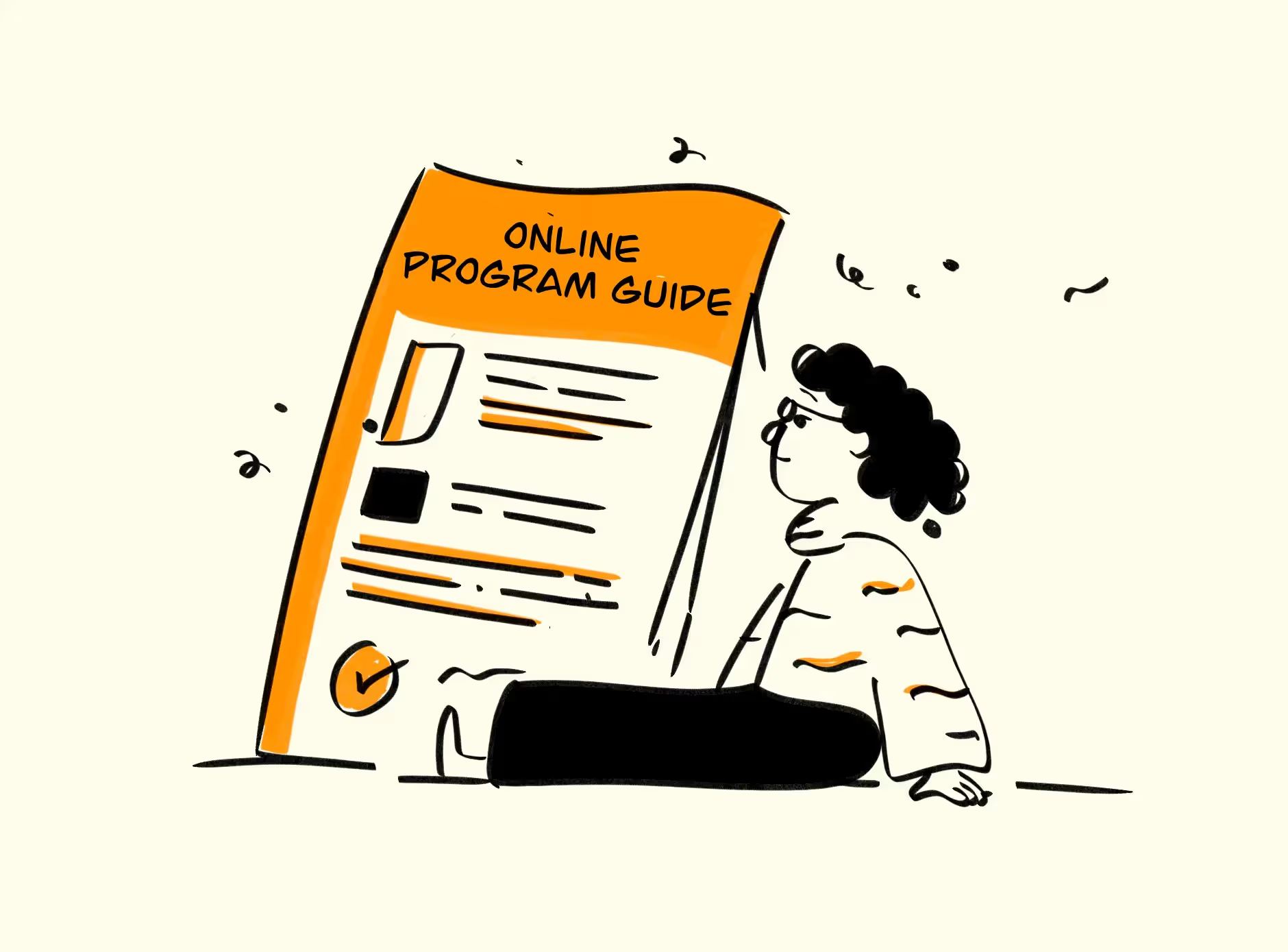![7 Things to Consider When Creating Online Courses [2025]](https://cdn.prod.website-files.com/62f0b227e38c6d799afcd8ba/6347e0dc266e9d4b29c8aad6_Do_Not_Create_Course_-min.avif)
![7 Things to Consider When Creating Online Courses [2025]](https://cdn.prod.website-files.com/62d6876535c5c7559909754c/67c036910fbf3721b5778e27_Attendance_Zoom-min%201.png)

Key Takeaways
- Optimize your course for mobile devices to reach a wider audience.
- Focus on creating quality content and marketing it effectively.
- Use the right tools, like EdisonOS, to streamline course creation and maximize success.
In 2025, online education is projected to grow even more, with increasing numbers of students and professionals looking for flexible learning options. If you're looking to create and sell online courses, understanding key trends and best practices can set you apart from the competition. Here are the top things you need to know before diving into the world of online course creation.
7 things you need to solve before creating an online course
1. Mobile Experience as the Key Differentiator
In 2025, mobile-first design will no longer be optional—it’s essential. In developing countries like India, where 1.14 billion people are expected to use mobile phones by 2025, mobile devices are the primary tool for accessing online education. According to a 2023 report by Statista, over 75% of internet users in India access the web exclusively via mobile devices, and this trend is growing globally.
For course creators, this means your content must be optimized for mobile. Learners expect a seamless experience, from video playback to easy navigation and mobile-friendly quizzes. Courses that aren't mobile-ready risk alienating large portions of potential students. A mobile-first approach includes:
- Responsive design that adjusts to different screen sizes.
- Mobile-optimized multimedia content, such as videos and images.
- Easy-to-navigate course structures that allow learners to progress smoothly, even on smaller screens.
By prioritizing mobile optimization, you not only make your course more accessible but also enhance user engagement, retention, and completion rates. In fact, studies show that mobile learners complete courses 45% faster compared to those on desktops, making mobile the key to staying competitive in 2025.
2. Target Audience
Before you start creating content, defining your target audience is crucial. Knowing exactly who you're speaking to allows you to tailor your course material to their needs, learning style, and pain points. Are you addressing beginners, intermediates, or advanced learners? Are they students, working professionals, or hobbyists?
Research your audience’s preferences and challenges to ensure your content resonates with them. A well-defined target audience leads to:
- Higher engagement rates.
- More effective marketing strategies.
- Improved course completion rates.
By creating a detailed learner persona, you’ll understand their motivations, challenges, and goals, allowing you to deliver content that feels personalized and valuable. This strategic approach not only enhances the learning experience but also boosts your reputation as a course creator.
3. Quality Content
In the crowded world of online education, quality content is your most significant differentiator. High-quality, well-researched content builds trust, keeps learners engaged, and encourages course completion. While flashy marketing might attract students initially, only valuable, actionable content will convert them into repeat customers or drive word-of-mouth referrals.
Here’s how you can ensure top-notch content:
- Thorough Research: Back your lessons with credible sources, up-to-date information, and practical examples.
- Engaging Multimedia: Incorporate videos, quizzes, infographics, and interactive elements to cater to different learning styles.
- Clear Learning Objectives: Define what learners will achieve after each module to keep them focused and motivated.
Research shows that 58% of online learners feel that the quality of learning materials is the most critical factor in their course selection. With that in mind, prioritize content that provides real-world value and practical applications, ensuring that students leave with the skills and knowledge they signed up for.
4. Pricing
Setting the right price for your course can be challenging but is critical to its success. Pricing too low might undervalue your content, while pricing too high could deter potential students. The key is to strike a balance between affordability and the value you provide.
Here are some tips for pricing your online course:
- Value-Based Pricing: Consider what your audience is willing to pay based on the value and results your course offers. If your course teaches a skill that directly impacts career growth, students may be willing to pay more.
- Tiered Pricing: Offering different pricing tiers (basic, premium, VIP) allows students to choose based on their budget and desired level of engagement. For example, a basic tier might offer course access, while a premium tier includes live Q&A sessions or additional resources.
- Competitor Research: Analyze the pricing of similar courses in your niche to stay competitive while highlighting what makes your course unique.
A study by Course Report shows that students are willing to pay an average of $12 to $99 for short courses and anywhere from $200 to $2,000 for more comprehensive, career-impacting content. Finding your sweet spot within this range will help attract the right audience while ensuring your course reflects its true value.
5. Usability
Usability is a crucial factor in creating a positive learning experience. Even the best content can fall short if the course is difficult to navigate or access. A user-friendly interface ensures that students can focus on learning rather than figuring out how to use the platform.
Key elements of a user-friendly course include:
- Simple Navigation: Make it easy for learners to move between sections, track their progress, and access course materials.
- Responsive Design: Ensure that your course works seamlessly across different devices—laptops, tablets, and mobile phones.
- Accessibility: Incorporate features like subtitles, downloadable resources, and adjustable text sizes to accommodate learners with different needs and preferences.
A study by the eLearning Guild found that courses with poor usability have a 60% higher dropout rate. Prioritizing a smooth, intuitive user experience not only enhances student satisfaction but also increases course completion rates, ensuring your learners stay engaged from start to finish.
6. Marketing Strategies
Marketing is just as important as the content itself, if not more. You could have the best course on the market, but without a strong marketing strategy, it won’t reach your target audience. Start marketing early—even before your course is complete—to build anticipation and attract potential students.
Effective marketing strategies include:
- Content Marketing: Share valuable insights, free resources, or blog posts related to your course’s topic to drive traffic to your landing page.
- Email Marketing: Build an email list by offering free resources such as eBooks, webinars, or cheat sheets. Use this list to nurture leads and gradually introduce paid courses.
- Social Media Campaigns: Leverage platforms like Instagram, LinkedIn, and Facebook to engage with potential learners, promote your course, and build a community.
- Partnerships and Collaborations: Team up with influencers, industry experts, or other course creators to expand your reach and credibility.
Remember, for every hour you invest in creating your course, allocate at least five times that amount to marketing. Building trust and visibility before your launch will increase the chances of success. Studies show that well-marketed courses have 3.5 times higher enrollment rates than those that lack a clear marketing plan.
7. Course Duration
Finding the right balance in course duration is key to maintaining engagement without overwhelming students. A course that’s too short may not provide enough depth, while a lengthy course risks losing students along the way. The goal is to create a learning experience that is both valuable and manageable.
Here are a few tips for determining course duration:
- Keep it Concise: Break your content into digestible modules. Research shows that learners retain information better when it's delivered in smaller, bite-sized pieces. Aim for short lessons of 5–10 minutes each.
- Offer Flexible Learning: Allow students to learn at their own pace with options for tracking progress and picking up where they left off.
- Consider the Learner's Time: Professionals or students with tight schedules will appreciate courses they can complete within a few weeks rather than months. You can offer supplemental resources or advanced modules for students who want to dive deeper.
A study by Thinkific shows that courses lasting between 4–8 weeks have the highest completion rates, with a 90% increase in engagement when lessons are shorter and structured into clear milestones.
Course Creation Tools
Choosing the right course creation platform is essential to ensuring your course development process is smooth and efficient. Whether you're just starting or scaling your course offerings, having the right tools at your disposal can make a world of difference. Here are some key features to look for when selecting a platform for creating online courses in 2025:
- User-Friendly Interface: A course creation platform should have an intuitive interface that makes it easy to design, structure, and organize your content. Look for platforms that offer drag-and-drop capabilities so you can seamlessly add multimedia elements, create quizzes, and develop interactive components without requiring technical skills. This ensures that even first-time creators can develop professional-looking courses quickly.
- Comprehensive Features: A good platform will offer a full suite of tools to enhance your course creation process. These include video hosting, interactive content, assessment tools, and real-time analytics to monitor student progress and engagement. A robust feature set enables you to deliver a dynamic learning experience that keeps students engaged and on track.
- Mobile Optimization: As more learners rely on mobile devices for education, it’s critical that your platform supports mobile-first design. The platform should offer responsive course layouts and optimized content delivery to ensure that students can access materials easily on any device.
- Scalability: Whether you’re starting with one course or planning to expand into multiple offerings, choose a platform that can scale with your needs. Look for integration options with marketing tools, payment gateways, and community-building features so your platform grows as your business does.
- Support and Flexibility: Having access to strong customer support is vital, especially if you encounter issues during course development or launch. Additionally, flexibility in pricing models (e.g., free, paid, or tiered courses) can allow you to cater to a wide range of learners, giving you control over how you monetize your content.
While there are many platforms available that meet these criteria, EdisonOS offers all of these tools in one place. Its intuitive design, mobile optimization, and comprehensive features make it an ideal choice for both beginners and experienced course creators. By streamlining the course creation process and supporting your growth, EdisonOS allows you to focus on delivering impactful learning experiences.
For educators looking for an all-in-one solution, EdisonOS stands out as a top platform to consider when planning your next online course.
Why Should You Consider EdisonOS for Creating Your Courses?
When it comes to creating and managing online courses, the right platform can make all the difference. EdisonOS stands out as an all-in-one solution that simplifies the entire course creation process, allowing you to focus on what matters most—delivering high-quality learning experiences. Here’s why EdisonOS should be your go-to platform:
- User-Friendly Interface: EdisonOS offers an intuitive drag-and-drop interface, making it easy for both beginners and experienced educators to create courses without technical expertise. The platform provides seamless tools for adding multimedia, quizzes, assessments, and other engaging content types to enhance learning.
- Mobile Optimization: With a mobile-first design approach, EdisonOS ensures that your courses are fully optimized for learners on the go. In a world where most users access content via mobile devices, this feature ensures your course reaches a wider audience, providing a smooth, user-friendly mobile experience.
- Comprehensive Features: EdisonOS provides everything you need to create, manage, and scale your courses:
- Video hosting with no external limitations.
- Assessment tools that allow for real-time grading and feedback.
- Analytics dashboards for tracking student progress and engagement.
- Community-building features, such as discussion boards, live Q&A sessions, and more.
These tools help you create an interactive and data-driven learning experience that keeps students engaged and on track.
- Scalability: Whether you're just starting with one course or looking to scale up to multiple offerings, EdisonOS grows with you. The platform integrates with key marketing tools, payment gateways, and CRM systems, ensuring that as your business grows, your course delivery remains smooth and manageable.
- Built-in Marketing and Sales Tools: EdisonOS doesn’t just help you create courses; it helps you sell them. With built-in marketing tools like email automation, landing page builders, and affiliate marketing features, you can promote your courses effectively. Plus, you can easily manage subscriptions, memberships, and pricing plans, giving you full control over your course monetization strategy.
- Support and Flexibility: EdisonOS offers exceptional customer support to guide you through the course creation and management process. The platform is flexible, allowing for free, paid, or tiered courses to match your business model and learner preferences.
Conclusion
Creating online courses in 2025 requires careful planning, strategic marketing, and the right tools to ensure success. From optimizing your content for mobile devices to understanding your target audience, each step plays a crucial role in building a course that delivers value and engages learners.
By focusing on quality content, effective marketing, and usability, you can stand out in a crowded market. EdisonOS provides a powerful platform to streamline the course creation process, helping you focus on what matters most—delivering impactful learning experiences.
Whether you’re just starting or looking to scale your online courses, the strategies outlined here will help you navigate the complexities of the online education landscape with confidence.

Recommended Reads
Recommended Reads











.png)
.webp)
